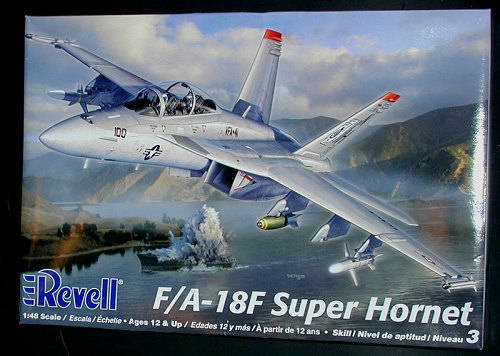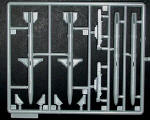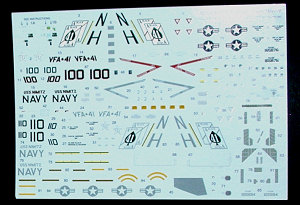
| KIT: | Revell 1/48 F-18F Super Hornet |
| KIT #: | ? |
| PRICE: | $21.50 from on-line auctions |
| DECALS: | Two options |
| REVIEWER: | Kurt Plummer |
| NOTES: | New Elements: Three Sub Trees, New Decals. |

| HISTORY |
Flight testing of the Super Hornet began in 1992 with delivery of the first production aircraft in 1998. Early testing revealed two significant aerodynamic problems with the aircraft. Most important of these was an uncommanded "wing drop" wherein one wing would suddenly stall without warning during certain maneuvers causing the aircraft to roll rapidly to one side. Modifications to the dogtooth as well as other wing adjustments corrected this undesirable behavior. In addition, turbulence beneath the wings was found to be so severe that it had the power to damage stores carried on the under wing pylons. This problem was corrected with a rearrangement of the under wing pylons so they are splayed outward, but at the price of increased drag and decreased performance at high speeds. Once again, a replacement aircraft is more expensive and provides somewhat less performance than the aircraft it replaces (F-14). You can thank the constant back-patting and intense lobbying by special interest groups, not to mention contributions to local politicians (all legal of course) for this.
Nevertheless, the F-18E/F has had enough modifications made to it so that it has proven quite successful and is currently in service with the US Navy. Current plans call for 548 aircraft to be procured as replacements for the F-14 and F-18A by 2010 with each carrier air wing receiving 12 F-18E and 14 F-18F models. Four or five of the aircraft delivered to each wing are also to be fitted with under wing "buddy stores" to serve as in-flight refueling tankers. An additional model is the two-seat EA-18G Growler electronic warfare platform intended to replace the EA-6B Prowler jamming aircraft. Ideally, six EA-18s would equip each carrier air wing. Though the Navy would like to acquire 1,000 F/A-18E/F units to serve until at least 2030, further production will be subject to the F-35 Joint Strike Fighter program. Singapore and Malaysia have also reportedly shown interest in an export version of the F/A-18E/F.
Historical section by your editor with help from a few internet websites.
| THE KIT |
 1. Added sprue on the
weapons/tank tree with 2 AGM-88 HARM and 2 LAU-118 rails.
1. Added sprue on the
weapons/tank tree with 2 AGM-88 HARM and 2 LAU-118 rails.
 2. Added Cockpit Sprue with
additional NACES seat, inter-cockpit coaming and main panel plus spine insert
(also the little sidestick controller gamingus').
2. Added Cockpit Sprue with
additional NACES seat, inter-cockpit coaming and main panel plus spine insert
(also the little sidestick controller gamingus').
3. Replacement Main Canopy along with rear hingepanel insert and strange looking 'rails'.
 4. VFA-41 Black Aces
Decals. CAG Bird and LoViz Squadron Aircraft.
4. VFA-41 Black Aces
Decals. CAG Bird and LoViz Squadron Aircraft.
Good things: Probably the best is the boxart. As can be seen, you have a lot more dynamicism along with near-Koike like photorealistic details and fairly decent proportions. GREAT JOB Revell! You've probably increased your Christmas sales by 30% on this alone compared to the entirely mundane E boxing.
Bad things: Rear cockpit is Lot 25 with the four small screens in a + rather than the Lot 26 ACS with the giant 8X10 AMLCD in a three-across format. The MFD detail is there but the buttons still have low relief so 'painting' is going to be best done with a colored pencil and a loupe.
 The new HARMs cost you the
GBU-31 JDAMs of the earlier single-seat kit. The AGM-88 are about dead on
for correct body diameter at 5.3mm but almost 3.5mm shy on length (near 84mm vs.
87.3mm), this then throwing out the proportional separation of the control wings
and tail group. Speaking of which, real HARM wings are facetted but _not
all the way around_. Just the quarter-chord area behind the leading edge
and then only to improve the aerofoil shape. As such, they are actually
quite thin whereas the kit versions are chunky while at 22mm is a tad
underspanned. This further torques the actually quite streamlined look of the
real weapon proportionally out of whack. Additionally, I have only found a few
developmental photos of HARMs with the giant fuselage bands shown on the kit
weapons and none at all on modern 88B/C versions. So given the typical
split-body assembly sequence with one set of fins molded on the missile with the
opposed set glued in after, I would save a lot of grief on seam cleanup by
hacking everything forward of the tail group down to the tube. Then insert a
sprue plug for length and clean up the seams before using one of the separate
control wings as a template to scratch build four fresh ones from sheet. Don't
forget that HARMs are also not 'white' as called out but F.S. 36622 or (for
scale effect) 36492 with a decidedly yellow/tan looking color value until faded
out.
The new HARMs cost you the
GBU-31 JDAMs of the earlier single-seat kit. The AGM-88 are about dead on
for correct body diameter at 5.3mm but almost 3.5mm shy on length (near 84mm vs.
87.3mm), this then throwing out the proportional separation of the control wings
and tail group. Speaking of which, real HARM wings are facetted but _not
all the way around_. Just the quarter-chord area behind the leading edge
and then only to improve the aerofoil shape. As such, they are actually
quite thin whereas the kit versions are chunky while at 22mm is a tad
underspanned. This further torques the actually quite streamlined look of the
real weapon proportionally out of whack. Additionally, I have only found a few
developmental photos of HARMs with the giant fuselage bands shown on the kit
weapons and none at all on modern 88B/C versions. So given the typical
split-body assembly sequence with one set of fins molded on the missile with the
opposed set glued in after, I would save a lot of grief on seam cleanup by
hacking everything forward of the tail group down to the tube. Then insert a
sprue plug for length and clean up the seams before using one of the separate
control wings as a template to scratch build four fresh ones from sheet. Don't
forget that HARMs are also not 'white' as called out but F.S. 36622 or (for
scale effect) 36492 with a decidedly yellow/tan looking color value until faded
out.
The clunkiness problem carries over to the LAU-118 rails. In fact, I don't know what was wrong with the Revell stores designer but nearly every piece of ordnance excepting possibly the AIM-9X and AIM-120C, is uncharacteristically thick. Pylons and Tank too.
As everyone who has read John Chung's review and buildup of their earlier single seater knows, the Revell Hornet's upper fuselage spine is significantly narrower and taller than it should be around the upper shoulders and this drastically altered the sit of the canopy rail. I have not yet test fitted the new canopy in comparison with the single seater kit or the Hasegawa but just on the sprue, it looks too tall and too narrow, despite being nominally bubbled (You can tell by the mold line down the middle of it).
| CONCLUSIONS |
A little disappointing, you lose one weapon to gain another and so the overall empty-pylon or fuselage station problem remains. This is particularly irritating given that there are still remaining sprue gates on the weapons trees in particular that could have been exploited to give the F/A-18F it's more common double bubble wing tank loadout and/or some of the unique-to-Iraq weapons that are not readily available in the Hasegawa Weapons Sets (Maverick E/F, GBU-12, _GBU-38_). Still, it 'looks like' a family model Bug and all the flaws are nothing more or less than those that characterized the single seater kit so if you got past that choker, this one shouldn't shock you much and will probably yield a lot more aftermarket markings options as the standardized Lot II and probably Lot III variants will both be majority twin sticked. Finding a Hasegawa F Hornet for less than 50 and even 60 bucks these days is a real chore and the Revell kit, for all its flaws (that inherited LEX kink and short length problem is very irritating and readily apparent, even on the boxart!) should remain a decent alternative to the Japanese item. My only question would be price, so long as the kit stays in the 20-25 dollar range via mail order or discount in the major chain stores, it's viable. But I wouldn't pay street retail of 27-35 bucks; the amount of plastic added vs. removed just doesn't warrant such a drastic change in MSRP, no matter how pretty the boxtop looks.
December 2006
If you would like your product reviewed fairly and quickly by a site that has over 325,000 visitors a month, please contact me or see other details in the Note to Contributors.